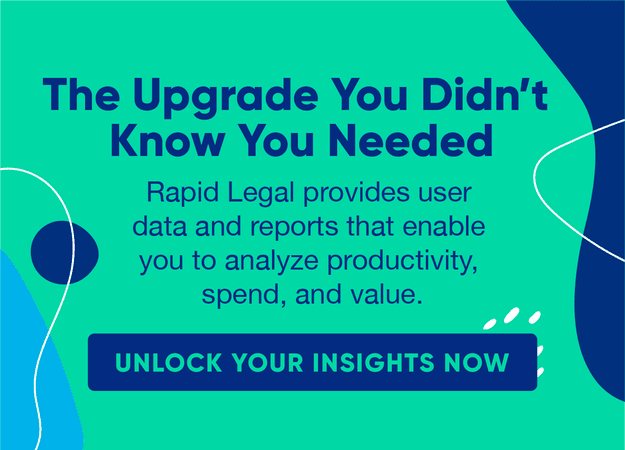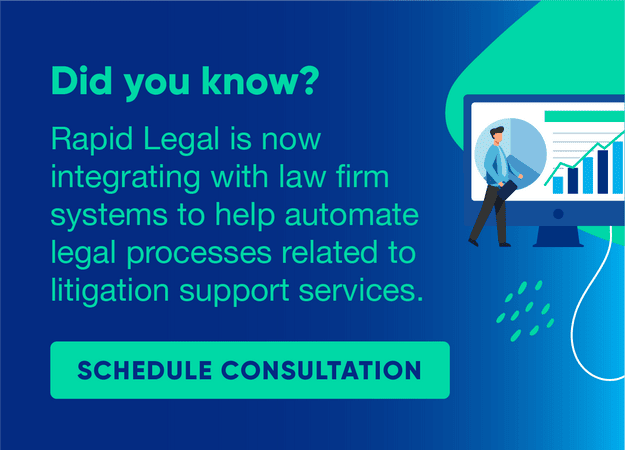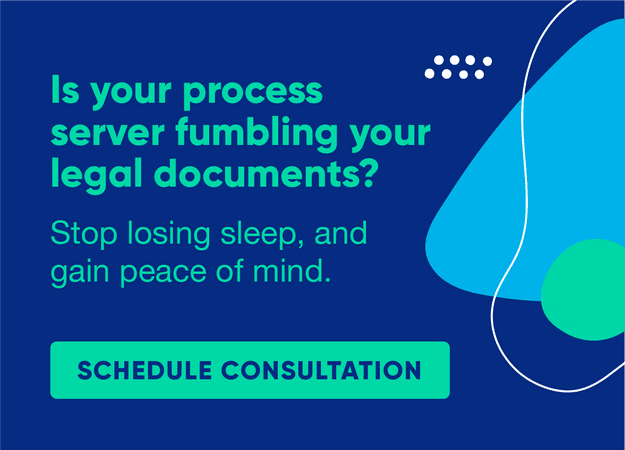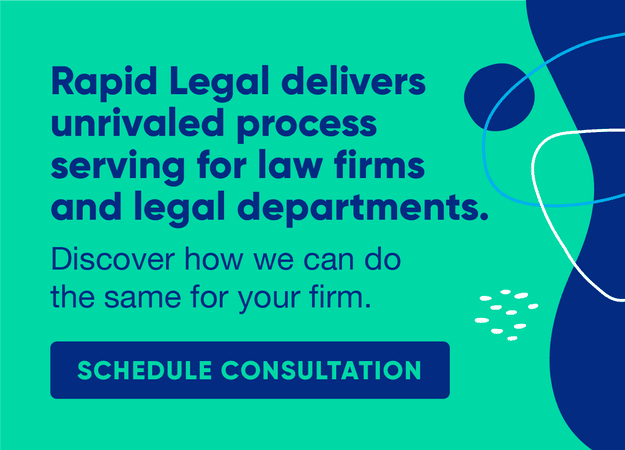The Analytics Advantage: Transforming Legal Practice with Data Insights
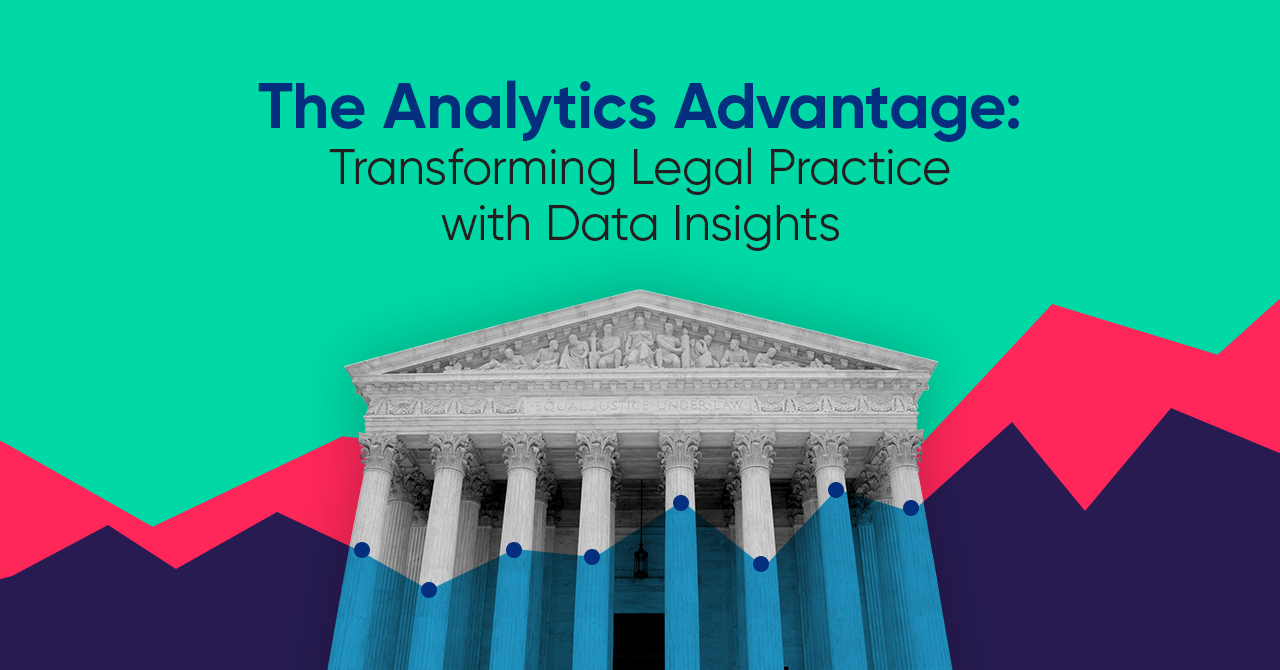
Driven by data and technology, the legal industry is undergoing a profound transformation, eagerly embracing the formidable force of analytics. Within the esteemed walls of law firms, a realization is dawning—a recognition of the boundless potential that lies in the art of harnessing data for enlightened decision-making, elevated client experiences, streamlined operations, and, above all, the rocket fuel for unprecedented growth. In this article, we share how legal professionals can harness the mighty powers of data and analytics, propelling their practices to unprecedented heights of success.
Understanding the Power of Legal Analytics
Legal analytics involves analyzing large volumes of legal data to derive meaningful insights. These insights can range from predicting case outcomes, understanding judge, and opposing counsel behaviors, identifying trends in legal disputes, to assessing the likely success of specific legal strategies. By tapping into legal analytics tools and platforms, law firms can gain a competitive edge and make data-driven decisions. And there’s no question they are because legal analytics adoption rates are on the rise.
A study by ALM Intelligence found that over 70% of law firms with 50 or more attorneys use legal analytics in some form1. Legal analytics is not limited to law firms. In-house legal teams are increasingly leveraging analytics to optimize legal spend, manage risks, and streamline operations. A survey by Blickstein Group revealed that 62% of in-house legal departments utilize legal analytics2. This speaks to a collective industry awakening, where the embrace of data-driven strategies is becoming the norm.
Enhancing Legal Practice
Legal analytics provides multifaceted advantages that significantly impact how legal professionals operate. Here are some ways in which analytics is transforming legal practice:
- Leveraging Predictive Analytics for Case Outcomes: Predictive analytics utilizes historical case data to forecast likely outcomes of legal disputes. By analyzing patterns and trends from past cases, law firms can advise clients with more accuracy and plan their legal strategies accordingly. This not only builds trust with clients but also improves the success rate of cases, contributing to the growth of the legal practice.
- Optimizing Client Services and Retention: Data analytics can shed light on client preferences, behaviors, and satisfaction levels. By analyzing client feedback, response times, case outcomes, and communication history, law firms can tailor their services to meet client expectations. Satisfied clients are more likely to provide referrals and become repeat customers, fostering organic growth for the practice.
- Improving Operational Efficiency and Efficacy: Efficiency is key to any successful business. Data and analytics can help identify bottlenecks in processes, enabling law firms to optimize their operations. By streamlining workflows, automating routine tasks, and allocating resources efficiently, legal practices can significantly improve productivity and cost-effectiveness.
Furthermore, data and analytics aren’t limited to the law firm’s own data. Firms should seek and leverage analytics and reports from their third-party vendors to gauge performance and ensure accountability. For example, to foster a partnership of transparency and accountability, Rapid Legal conducts quarterly business reviews with key clients and shares data metrics and insights on staff productivity, eFiling performance, service of process success rates, county court filing distributions, and more.
Equipped with these analytics, law firms and legal departments are using them to manage staff productivity, minimize filing errors, achieve faster court-document turnaround times, and cultivate greater accountability for their own teams and their vendors.
Ensuring Compliance and Risk Management
Legal analytics can also assist in monitoring and ensuring compliance with various regulations and ethical standards. By analyzing data related to compliance protocols, law firms can identify areas of potential risk and take proactive measures to mitigate them. This helps in maintaining a solid reputation and avoids legal complications that could impede growth.
Harnessing the Power of Data and Analytics for Law Firm Success
While legal analytics offers immense potential, it’s not without challenges. Privacy concerns, data quality, and the need for skilled data professionals are among the hurdles that need to be addressed. However, the legal landscape is evolving, and data-driven decision-making is becoming increasingly essential for growth and success.
Legal analytics, as we’ve explored, is a transformative force for the legal profession, offering multifaceted advantages that revolutionize how legal professionals operate. Predictive analytics stands as a beacon of precision in advising clients and planning legal strategies. In the client-centric realm, data analytics illuminates preferences and satisfaction levels, enabling tailored services that foster trust, referrals, and repeat business. Efficiency and efficacy soar as legal practices optimize operations through streamlined workflows, automation, and smart resource allocation.
Yet, the power of data and analytics doesn’t stop at a firm’s threshold—it extends to third-party collaborations, promoting transparency, productivity, and accountability. Moreover, legal analytics emerges as a stalwart guardian of compliance and risk management, identifying potential pitfalls and enabling proactive measures to preserve reputations and avert legal entanglements.
In this era of legal evolution, the marriage of data and analytics isn’t just a strategy; it’s an imperative. It’s the North Star leading legal practices towards a future where success is measured by informed decisions, delighted clients, streamlined operations, and a resilient foundation built on compliance and trust. The potential is boundless, and for those who embrace this transformation, the trajectory of success knows no bounds.
A Data-Informed Law Firm Requires a Data-Driven Litigation Support Service Partner
Rapid Legal has deep industry knowledge and experience with physical court filing, eFiling, and service of process combined with technology expertise and solutions to address the needs of today’s law firms. Learn how we can help your firm streamline litigation document workflows, leverage data, integrate systems, and more. Book a demo or schedule a call with us today to discuss how we can best support your firm’s needs.
AI + The Lawyer: Keep Calm and Practice On

It’s safe to say that Artificial Intelligence (AI) is here. While the stunning technology used to be reserved for Sci-Fi concepts, OpenAI’s Chat GPT, propelled by its biggest investor, Microsoft, is seeking to revolutionize the capabilities of AI, our expectations of it, and its uses. AI is being applied in virtually every industry, so it’s no surprise that the legal industry is learning how to apply it to the practice and business of law. The AI deluge raises an immediate question for lawyers: how is this going to affect my job?
This article explores the nuanced relationship between AI and law firms, examining whether it acts as a disruptive force or a valuable augmentation. We’ll examine how AI is affecting the business of law, how the role of the lawyer will likely evolve, and what skills the lawyer of tomorrow may need.
Keep Calm and Practice On
Before we get started, let’s make one thing clear: lawyers are not going anywhere anytime soon. The same can be said of legal assistants, paralegals, and legal administrators. Thus, law firms are not going anywhere. In fact, both lawyers and legal assistants/paralegals both have healthy job outlooks, according to the U.S. Bureau of Labor Statistics as they’re expected to grow by 10% and 14% from 2021 to 2031, respectively.
While the supercharged efficiency AI creates has the potential to drastically reduce operating costs for law firms, how law firms generate revenue is still relatively the same. That’s because the law firm’s most precious commodity remains unchanged: judgment.
Danielle Benecke, the founder and global head of Baker Mackenzie’s machine learning practice, said on Law.com’s podcast, Legal Speak, that the “ultimate driver” in the legal industry is a lawyer’s judgment. Benecke went on to state AI is a “significant advance along this continuum of technology advances that drive and grow our business model.”
Rather than replacing a lawyer’s judgment, Benecke and other lawyers see AI as a tool to “enhance” their judgement. For example, a novel use of AI that is being considered is using AI as a tool to predict legal outcomes, or the likelihood of the success of a case, which allows a lawyer to decide if they want to take a case on contingency or if they should advise their client to settle and more.
Tomorrow’s Lawyer: With Great Technology Comes Great Upskilling Required
AI is already being used to make legal professionals more efficient by automating simple yet time-intensive processes such as discovery, research, and drafting motions. What normally takes hours could be performed in a matter of minutes, which will allow both paralegals and lawyers to focus on higher-value tasks. In essence, AI will enable legal professionals to get more done in significantly less time using fewer resources, thus reducing operational costs.
A spike in efficiency and productivity throughout the industry will also create an even more competitive environment between lawyers. Ben Allgrove, the Chief Innovation Officer at Baker McKenzie, stated in a New York Times article that AI will force everyone, “from paralegals to $1,000-an-hour partners, to move up the skills ladder to stay ahead of the technology.” In layman’s terms, everyone is going to have to step up.
Breakthrough technology brings a Darwinian dimension to any business arena it affects: adapt or die. Such is the case with the legal industry. If lawyers are to have a bright future practicing law, it behooves them to understand AI.
If a lawyer is going to be proficient in AI, there are two major skills he/she should learn: prompt engineering and explainable AI (XAI.)
Prompt Engineering
Prompt engineering refers to the practice of fine-tuning and optimizing the inputs or queries given to an AI system to elicit desired outputs or responses. It involves carefully crafting instructions or prompts to guide the behavior of the AI model and achieve specific goals. The focus is on understanding how AI models interpret and respond to different inputs.
A lawyer with a strong grasp of prompt engineering will know what questions to ask a language model and how to word those questions to contextualize their situation. They would be able to ask a language model about a specific client’s needs, their scenario, and legal implications within which they’re working so the model can help them strategize.
For example, if a record label wanted to mint NFTs for a debut album of one of its artists, its in-house attorney would be able to ask a series of questions and provide a list of parameters to an AI model that would, in turn, produce say, a contract that covers royalties, IP law, and copyright law in just a few minutes.
While many in the legaltech space see prompt engineering as the next critical skill in the practice of law, the framework around how AI is regulated and taught still needs to be created. Regulations governing AI and the use of language models in law will develop as the market evolves, which will lay the foundation for legitimate curriculum law schools and colleges. Some universities and third-party services offer certificate programs; however, few accredited universities and law schools offer courses on prompt engineering.
Explainable AI (XAI)
Explainable AI (XAI) is a set of techniques and methods that help us understand how AI systems make decisions. It provides a window into the “mind” of the AI system, allowing us to see the reasons and factors behind its decisions. XAI aims to make AI more transparent and understandable, so we can trust and verify its decisions.
It may be a surprise to many, but AI has biases just like humans, so it’s critical for users to understand the steps and logic AI uses to reach a decision. Lawyers who use AI in the future will need to understand its biases so they can create more accurate work and minimize errors. XAI helps us trust and understand the decisions made by AI systems and the lawyers who will use them.
The buzz around XAI is not as intense as prompt engineering, and one could make a strong argument that XAI is more complicated and technically harder than prompt engineering, however, it is still immensely valuable. Lawyers with a strong grasp of XAI will be able to identify problems in AI’s logic and then solve them. A stout understanding of XAI will even augment a lawyer’s skill to engineer prompts.
Of course, once AI becomes ubiquitous, the most successful law firms will be the ones who utilize it in the most creative, practical, and critical manner. AI may be “smart tech”, but it is only as savvy as the practitioner using it, and how they use it to improve business outcomes for their law firm.
Third Party Legal Support Service Providers
Like law firms, third-party service providers will also be seeking to benefit from AI by enjoying increased efficiency, greater output, and greater accuracy. For Rapid Legal portal users, that will mean fewer court rejections, more intuitive commands in the ordering workflow, and a better customer experience. Stay tuned.
Conclusion
There’s a lot about AI and how it will ultimately affect the legal industry that we don’t know today. It’s in its nascent stages. But like the smartphone’s radical effect on modern society, AI will be a game-changer in the legal industry. And despite lawyers being famous for not adopting technology on the cutting edge, the benefits they will enjoy from AI are monumental. Yes, legal professionals will have to level up their skills, but the advantages AI will bring will far surpass any cost or challenge.
Contact Us Today
To learn more about Rapid Legal’s technological innovation and automation initiatives in the law firm, schedule a call or book a demo with a Rapid Legal team member today. Rapid Legal can also help your law firm with all its eFiling, court filing, and process serving needs.
Is Cybersecurity Limiting The Modern Law Firm?

In the digital age, cybersecurity is no longer a luxury, it’s a necessity. This sentiment doubles for law firms, which are being bombarded by ransomware attacks, data breaches, and a litany of other data-related issues daily.
As cyber threats continue to get more sophisticated, the methods firms need to take to protect themselves grow more complex, time-intensive, and expensive. As if running a practice and protecting themselves on the digital front weren’t enough, lawyers nowadays must go through technology training simply to stay current with data security practices.
If that all sounds like a lot, it’s because it is, which begs the question: is cybersecurity limiting the modern law firm? This article will explain the host of obstacles with which modern law firms grapple to cover their digital bases, what security capabilities law firms should look for in third-party vendors, and how third-party providers such as Rapid Legal are stepping up to give them peace of mind.
The Complexity of Cybersecurity:
Cost
One of the biggest challenges law firms face when implementing robust cybersecurity measures is the cost. Cybersecurity solutions can be expensive, especially for smaller firms with limited budgets. A survey from the International Legal Technology Association found that firms were increasing their spending on cybersecurity and security assessment software by 40% and 44%, respectively.
This increase in spending is substantial for big law firms that have the millions of dollars and resources to afford cutting-edge cybersecurity, but smaller firms with limited funds can easily find themselves shelling out more significant portions of their budgets if they’re to have top-of-the-line cybersecurity. This reason is why small firms are the most vulnerable to cyberattacks.
The cost of implementing and maintaining these solutions, as well as training staff on how to use them effectively, can add up quickly. Moreover, these costs can limit the ability of law firms to invest in other areas of their business, such as hiring additional staff or upgrading their technology.
Training
Employing cybersecurity measures, including training, is neither a simple nor an easy task. It requires technical expertise and knowledge that oftentimes requires law firms to get from an outside consultant. Law firms need to work with cybersecurity professionals to develop a plan that meets their unique needs and requirements, while small firms must sacrifice precious resources to protect themselves.
Regardless of the scope of the law firm’s needs, these security plans almost always require some sort of training for the legal staff. While this training is important to the overall data hygiene of the law firm, this process can be a time-consuming and complicated process that limits the productivity of legal professionals.
Technology training has become so commonplace in the legal industry that 75% of respondents in the 2022 Survey from the ABA reported having technology training at their firms. According to the survey, 100% of the firms with over 100 attorneys that responded to the survey had technology training available for their attorneys.
Interested in cybersecurity and other technology-related matters?
Check out this thought-provoking article:
Technology By Itself Does Not Make a 21st Century Law Firm
User Error
One of the most critical weak points of any enterprise’s cybersecurity is user error. Even with strong cybersecurity measures in place, law firms are still vulnerable to data breaches and cyberattacks due to user error. Human error may seem like an anticlimactic or even silly source of error, but studies have shown it can be difficult to remedy as scams and phishing emails have become increasingly sophisticated.
These errors can include everything from employees falling for phishing scams to leaving their devices unlocked and unattended. While it is becoming an industry standard to train legal professionals to spot scams, human error will be a constant weak point so long as humans are using their devices.
While there are many different types of breaches and cybersecurity threats to be aware of, phishing is the most common. The 2021 Verizon Data Breach Investigation report found that phishing was present in 36% of all breaches.
Even more daunting, the Cybersecurity & Infrastructure Security Agency (CISA,) found that 90% of all cyberattacks begin with phishing, Intel’s International Security Quiz found that a staggering 97% of email users cannot identify a phishing email.
Compliance and Regulations
Law firms also face other obstacles when implementing cybersecurity procedures, such as compliance requirements, regulatory changes, and evolving cybersecurity threats. Compliance requirements can be complex and time-consuming to follow, and failure to comply can result in costly fines and legal action.
Cybersecurity has also affected the California state’s legislation. The California Consumer Privacy Act (CCPA) and California Privacy Rights Act (CPRA) are two of the most notable pieces of legislation affecting law firms.
The CCPA applies mostly to mid to large-sized firms as it applies to companies and for-profit firms that gross over $25 million, firms that sell the personal information of 100,000 or more California residents, or firms that derive 50% or more of their revenue from selling consumers’ personal data.
To be compliant with the CCPA, a law firm must implement certain measures, such as ensuring transparency in their data collection practices and providing customers with the right to access, delete, and opt out their personal information.
These businesses and law firms must also have clear privacy policies that outline their precise use of the customer’s data, as well as train employees to understand CCPA requirements and undergo regular audits and assessments.
The CPRA builds off the CCPA and imposes additional obligations to protect the privacy of personal information. Sometimes referred to as “CCPA 2.0,” CPRA shares the same revenue criteria as CCPA, although it is far stricter and more thorough in its auditing of a firm’s data collection, processing, and storage practices. Failure to comply with either act will result in costly penalties for the firms.
Regulatory changes can also impact the way law firms handle client data and require them to update their cybersecurity policies and procedures accordingly. Cybersecurity threats are constantly evolving, which requires legal professionals to stay up to date on the latest trends and best practices.
Court Rulings and Liability
Recent court rulings are making companies and law firms more liable for data security practices. In September 2022, the United States Third Circuit Court of Appeals remanded a putative class-action lawsuit against ExecuPharm, a pharmaceutical company that suffered a data leak due to a phishing scam.
What’s notable about this ruling is that the District Court had previously dismissed the case due to its speculative nature since the lead plaintiff’s information had not suffered any identity theft. Upon review of the case, the Appellate Court ruled that the plaintiff still had a substantial risk of imminent injury due to the intentional nature of the cyber-attack.
The case, which was sued under the Class Action Fairness Act for negligence, breach of contract, breach of fiduciary duty, and breach of confidence, also determined that intangible injuries such as having your data stolen and the emotional distress of having your data leaked are sufficient to file suit against a corporation. Now more than ever, companies and law firms are liable for the security of their client’s data.
Third-Party Risks
Law firms often work with third-party vendors, such as eFiling service providers, court reporting services, and e-discovery providers, that may have access to sensitive data. If these providers have access to your firm’s system, their vulnerabilities can become yours.
Ensuring your third-party vendor has up-to-date security and is compliant is critical when choosing providers. For DLA Piper, who suffered a massive ransomware attack in 2017, their leak was caused by a compromised supplier.
Key considerations to verify when working with third-party vendors include:
- Data Encryption: Does the vendor encrypt data both in transit and at rest? Encryption ensures that if data is intercepted, it is unreadable.
- Compliance with Industry Standards: Does the vendor comply with all rules and regulations about data privacy and personally identifiable information (PII), cardholder data, and more?
- Regular Security Audits: Does the vendor conduct regular security audits to identify and mitigate potential security risks?
- Disaster Recovery and Business Continuity Plans: Does the vendor have disaster recovery and business continuity plans? These plans ensure that if there is a security breach or other disaster, your data is safe, and your business can continue operating.
- Access Controls: Does the vendor use strict access controls? This ensures that only authorized users have access to sensitive data.
- Redundancy: Does the vendor store their data in multiple data centers? Having their data stored in multiple data centers will ensure your data will be available and secure in the event one of those data centers is compromised.

How Bad Are Data Breaches, Really?
The recent high-profile data breaches have underscored the need for robust cybersecurity measures in the legal industry. For example, in 2016, a Panama-based law firm, Mossack Fonseca, suffered a significant data breach, which led to the leak of 11.5 million confidential documents. The Panama Papers leak exposed the financial dealings of some of the world’s most powerful individuals and companies, resulting in significant reputational damage to the law firm.
Similarly, in 2017, DLA Piper, one of the largest law firms in the world, suffered a significant ransomware attack that affected their systems in the United States, Europe, and Asia. This cyber-attack was so severe that it required the firm to shut down its systems entirely.
Aside from the massive reputational blow data breaches deal, there’s also a crippling cost element that comes with a major data breach. A 2022 report by IBM and the Ponemon Institute calculated the average cost of a data breach to a US company to be a staggering $9.44 million. Suddenly the exorbitant cost of cybersecurity doesn’t seem so steep.
When it comes down to brass tacks, cybersecurity is indubitably a critical part of any law firm’s digital infrastructure. While staying current with cybersecurity regulations and technology is difficult and time-intensive, practicing good digital hygiene can save your law firm from a catastrophic data breach or malware attack.
Rapid Legal’s Portal Delivers Professional-Grade Security and Compliance
As a certified eFiling service provider with 35+ courts in California, including the largest court system in the nation, Los Angeles Superior Court, Rapid Legal’s litigation support service portal is used daily by thousands of legal professionals to file and serve their legal documents. That’s why it’s built with security in mind. We follow industry best practices to ensure the privacy and security of our client’s data.
Professional Grade Security and Compliance
- Advanced Firewalls – military-grade data encryption
- Rigorous registration and authorization protocols
- Certified Electronic Filing Service Provider (EFSP)
- PCI Compliant
Industry-Leading Technology Integrity
- Amazon Web Services enabled
- Highly automated, redundant, and scalable
- On-Demand availability 24/7
Ultimately, cybersecurity is both a nuisance and a salvation for the modern law firm. One cannot overstate its importance to the security of a firm’s and its client’s data, however, the growing complexity of these practices, training employees, and staying current with industry-standard practices and compliances is a massive undertaking.
Perhaps the more critical issue is how sophisticated scams are becoming. It almost seems that the moment a breakthrough security innovation happens, a new malware or hacking program cancels it out. Thankfully, with blockchain technology, AI, and even quantum computing (which is on the far horizon,) law firms and their IT partners will be able to combat these malicious issues and hopefully solve them once and for all.
Do You Care About Cybersecurity? So Do We.
If you’re interested in a vendor that offers secure, reliable eFiling, court filing, or process serving, schedule a call or book a demo with a Rapid Legal team member today!
We also have an extensive resource library where you can find guides, checklists and other resources to help you eFile documents according to the local court rules in each county as well as what qualities to look for when selecting an eFiling service provider or process serving vendor.
Process Serving: Is Rushed Service Worth the Price?
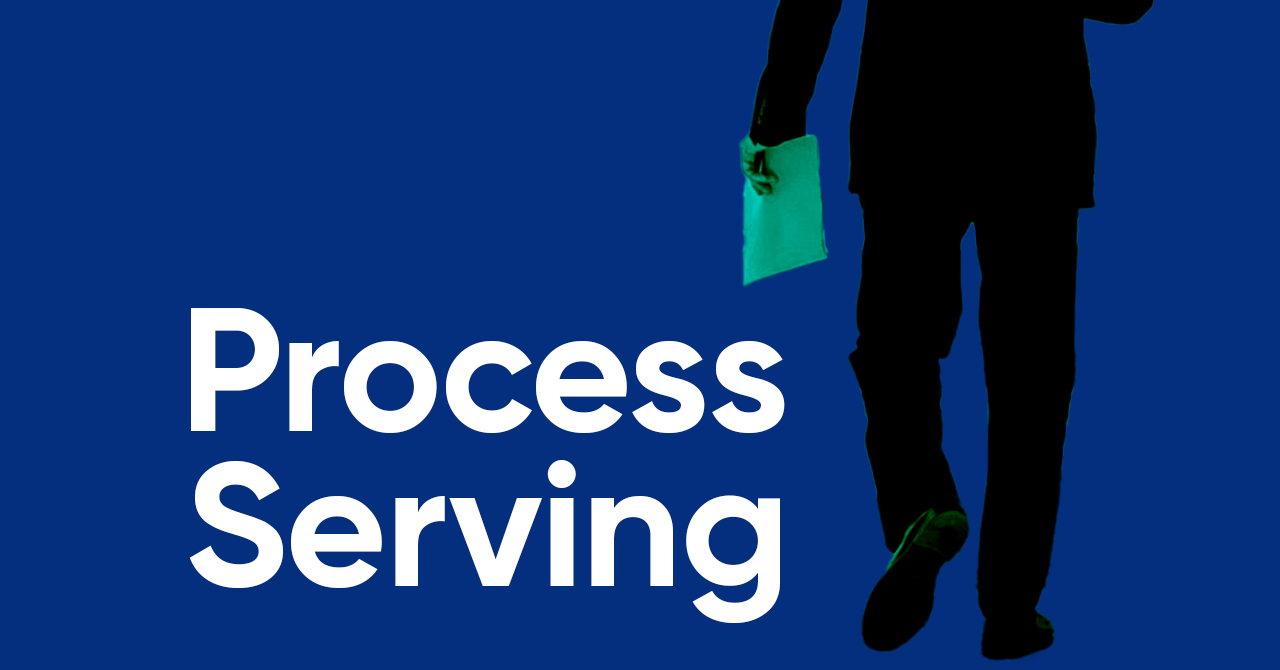
In today’s fast-paced world, time is money. This is especially true in the legal industry where clients expect law firms to resolve their cases as quickly as possible but at a cost-effective price. As a result, litigation support services that promise supersonic process serving are often seen as paramount, but are rushed services worth the price you pay?
In this article, we’ll explore the true cost of rushed litigation support services and help you evaluate whether the urgency you think you need is worth the price you pay. We’ll also show you how reporting data can help you identify where you’ve been losing money on difficult serves or unnecessary on-demand services, and help you decide whether it’s really worth it.

A Need for Speed
Before we dive into the cost of speedy litigation support services, let’s first define what we mean by “speed.” In the legal industry, speed is typically measured by the time it takes to serve legal documents or the time it takes to complete a legal support task related to a case.
Litigation support services that promise faster turnaround times and more efficient processes are often more expensive than those that offer slower service levels.
Not Every Matter Is Urgent, And That’s Okay
However, not all legal cases require ultra-fast service. For example, a routine document retrieval task may not require expedited service, and choosing a slower service level could save you, and thus, your client, money. On the other hand, urgent matters such as restraining orders or emergency motions may demand immediacy requiring you to pay a premium for expedited service.
Different circumstances call for different levels of urgency, so it’s important to evaluate your needs and determine whether the exigency you think you need is worth its steeper price tag.
Do you think you know a good service of process provider when you see one?
Test your knowledge here:
What to Look for When Hiring a Process Serving Company.
To help you evaluate your options, we’ve included a table that shows how Rapid Legal’s service levels differ and what a law firm can expect to pay for each. This table can help you determine which Rapid Legal service level is right for your needs and budget.
| Service Level | Attempts Timeframe | Cost* |
| Standard | 1st attempt within 5 days | $80 |
| Priority | 1st attempt within 1 day | $110 |
| Urgent | Urgent (Same Day Attempt, if received by deadline | $170 |
| On-Demand | Immediate processing** | $245 |
*Prices are based on services up to 50 pages. For services over 50 pages, Rapid Legal charges a document set-up fee of $.50 per additional page.
** Attempt must be received by 1:00 PM PST within California and 10:00 AM PST outside California.
Please note: Services, prices and deadlines are accurate as of this posting. For the latest information, please visit our prices and deadlines page.
As you can see, the cost of litigation support services increases significantly as the attempt’s timeframe decreases. While faster service levels may be necessary for urgent legal matters, it’s important to evaluate whether the cost is worth it for routine tasks.
Things to Keep in Mind
It’s also important to understand that the level of service does not guarantee the process server will complete a process serving order on their first attempt.
While selecting a rush service means the process server will attempt to serve the legal documents sooner, a host of variables exist that can slow down service, from providing the case participant’s incorrect address to the defendant evading service entirely.
However, on average, legal professionals should expect their litigation support service provider to complete a service of process order and deliver the proof of service back within a week.
In addition to evaluating your service level needs, you should also analyze your reporting data to identify where you’ve been losing money on difficult serves or unnecessary on-demand services.
Rapid Legal conducts Quarterly Business Reviews with our clients to share service of process success rates, proof of service turnaround times, and other insightful user and order data to help you manage the productivity of your staff as well as the performance of our services.

While speedy litigation support services may be necessary for urgent legal matters, it’s important to evaluate whether the urgency you think you need is worth the price you pay. In many instances, your firm may be overpaying for a service that doesn’t require rushed service.
By analyzing your needs, evaluating service levels, and tracking your expenses, you can make more informed decisions about how to allocate your resources and save money on litigation support services.
If you would like to learn more about Rapid Legal’s superior process serving performance or reporting and analytics that deliver transparency and accountability to our law firm clients, schedule a call or book a demo today.
8 eFiling Hacks You Need to Know

Ever caught yourself thinking, “I can’t possibly work any harder?”
We may not be able to help you work harder but we can help you work more efficiently, and some days that may be all you really need to manifest your inner eFiling rock star.
To help you get there, we’ve hand-selected eight hacks that unlock time-saving features when you eFile court documents in the Rapid Legal portal. Read on, bookmark this page, and use it like a get-rich-quick scheme for your productivity.
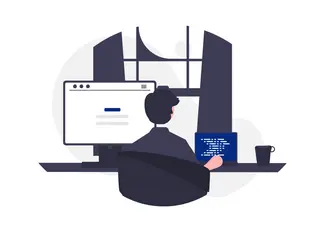
8 eFiling Hacks
Our Concierge Service is the ultimate shortcut for the world’s busiest legal professionals. Hand over the entire eFiling to a Rapid Legal expert who formats and assembles your document. This personal service includes checks and corrections to verify:
- Documents are not corrupted or password-protected.
- Font size and style are correct.
- Pages are paginated correctly.
- Summons matches the complaint.
- All mandated forms are attached.
- Exhibits are electronically bookmarked.
- Text is text-searchable.
This service may be the fastest headache reliever available for many legal professionals. However, Concierge Service is only available to registered account owners, so if you’re not yet a Rapid Legal account owner and you know you’re going to need capable and experienced backup, create an account now.
Concierge Service Does More!
See all of the services you get with Rapid Legal’s Concierge Service on our website.
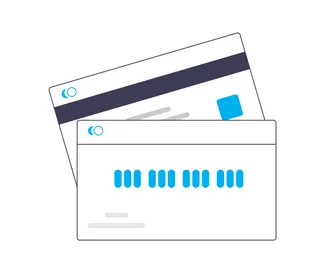
2. Fees Tab: Your eFiling is less likely to be rejected by the court if you pay close attention to the Fees Tab, so take charge of this seemingly small detail. Even if the rest of your eFiling is bulletproof, an improper fee amount will send your efforts off the rails.
Each time you see the fees tab, remember:
- You must enter the correct fee amount in the Fees tab. If your fee amount is incorrect the order will be rejected.
- Selecting the option to authorize Rapid Legal to advance the fees does not automatically pay the fees to the court.
- Subpoena Witness Fees can trip you up. If you’re not sure when a Subpoena Witness Fee is required check The Code of Civil Procedure of California.

3. Document Management System Integration with iManage and NetDocuments: Use this new integration to upload and download documents for your eFiling orders directly from the Rapid Legal portal. If you’re a high-volume eFiler this will save you hours of time over the long haul.
Using this streamlined feature is simple:
- Log into the Rapid Legal portal for direct access and use the search tool to locate a specific document.
- To place an eFiling order, select documents from your NetDocuments or iManage account once it’s time to upload the documents.
- Court-stamped documents are automatically saved to your NetDocuments or iManage account.
- The document(s) the courts return will transmit directly to your DMS account — and you don’t have to do a thing.
And just like that, you eliminated the need to download, import, and rename files on your local computer.
See it in action! Watch the video and discover how legal professionals use this integration for seamless document transfer.

4. Expert Review: Our in-house experts spot errors prior to court submission to increase the likelihood that the court clerk will accept your eFiling. This service increases your court eFiling acceptance rate and helps you reclaim the time you’d spend doing a detailed review yourself.
Each expert review places a laser focus on your documents to verify that:
- Signatures and dates are entered as required.
- Document titles are correct.
- Court locations and addresses are entered correctly.
- Names and parties on the documents match.
- Case numbers match and documents are conformed (if applicable).
- Correct document titles are selected (this assures fees are correctly paid to the court).
There’s more to the complete Expert Review audit that we can list here. Visit the Expert Review page on our website to see what the full scope of this premium service offers.
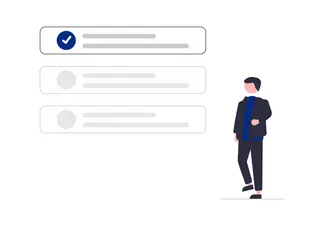
5. Stand-alone eService: Get exactly what you need, when you need it. Place stand-alone eService orders on the Rapid Legal portal independent of a court eFiling order.
Here’s how it works:
- Party A sends an email to Party B, notifying Party B that a court document(s) has been served.
- The email identifies the court document(s) by the document’s specific name.
- The email contains a secure link Party B can use to view and download the court document(s).
Stand-alone eService is available in two workflows:
- Workflow for California courts that have eFiling.
- Workflow for California courts that do not have eFiling.
Better eFiling Pricing? Yes, You Can.
Find out how many large companies drive down vendor prices and get preferred treatment by How Law Firms Can Get Better Pricing and Service with a Single, Preferred Provider on the Rapid Legal blog.
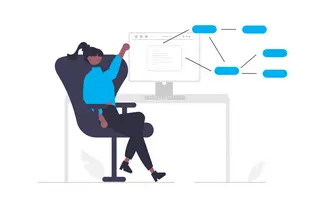
6. Manage Cases: A simple solution to track the status of your orders for any of your cases in your Rapid Legal portal.
To navigate the Manage Cases feature, follow these simple steps once you log into your Rapid Legal account:
1. Click on Manage Cases and search your case by its name or by its order number.

2. Search for any case that has been active over the last 90 days either by case name or case number.
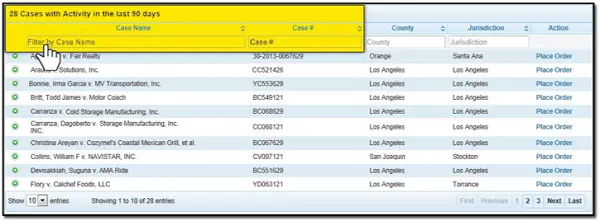
3. Select the green plus sign to expand the case, then select the order for details.

Manage Cases is where you can also find your conformed copies or proofs of service. Select the Documents tab to locate and view all documents related to the specific order.
Case not found?
If you receive a “Case not found” error message when attempting to place an eFile order, check other filings you may have done for the format of the case number. Most cases have letters at either the beginning or the end of the number.
7. PDF Preparation: Alerts from the Rapid Legal portal can help you stay on top of potential errors when you’re creating a PDF. Still, you want to strive to create an error-free PDF before it leaves your desktop, so use these tips to keep your eFiling on track and out of the rejection bin.
- Make your PDFs searchable.
- Compress PDFs correctly.
- Do NOT make PDFs locked or fillable.
- Do you have a fillable document that’s giving you fits? Print the document to PDF or print and rescan then upload on the Documents tab.
Received a “corrupted or invalid PDF” error message?
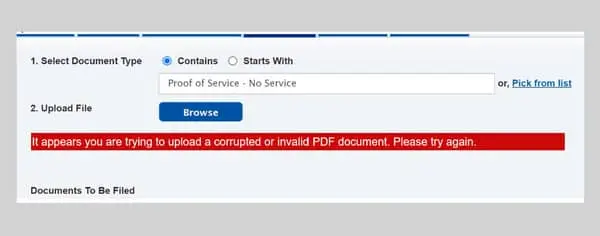
If this happens, check the top left-hand corner of the screen to see whether the document is locked. The court will not accept locked documents.
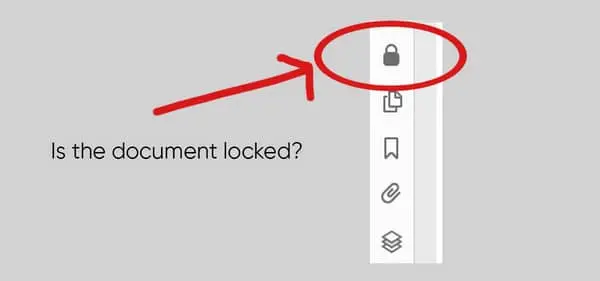
You can resolve this error by:
- Printing and scanning the document and saving to desktop or
- Saving the document to .pdf then saving it again to the desktop.
PDF larger than 100 pages?
If you’re working with a particularly unwieldy PDF remember this important rule: the deadline for court documents that exceed 100 pages is 1 hour earlier than the normal deadline.
8. Support: You have several options to work through issues that may crop up when you eFile, including email and phone support. You may also use Rapid Legal’s chat feature as a time-saver when you need to connect with a member of our operations team.
Regardless of the method you select, use the table below to find a hack that will get the fastest, best results from your support session.
When using our chat feature: Be sure to include your account number or order number while asking a question. If there is a document with which you need assistance, you may attach the document to the chat so the operations team can review it while the chat is in progress. Attaching the document will make your chat process more efficient. | Order or case numbers: Any communication with our operations team members should include a Rapid Legal order number or case number. | No email links, please: To keep our systems safe and minimize security risks, our operations team members do not review links that are sent in emails. Please do not send a link inside an email to team members. |
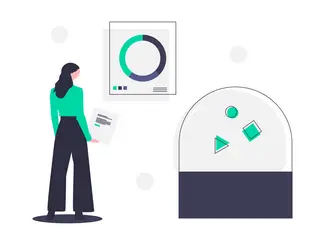
You’ve only scratched the surface!
We’ve got even more resources to help you develop your eFiling expertise. Tools such as our Infographic: 5 Secrets to Successful eFiling and [Updated] The Complete Beginner’s Guide to eFiling in 2022 and Beyond can improve the results you’re getting from your eFiling no matter your experience level. The Rapid Legal blog also has exclusive content tailored to sharpen your expertise for the litigation support services you use most. You’ll get the best in technical guidance, professional development, and roadmaps to visualize how your law firm will leverage technology in the 21st century.
It’s all there to view, download, and share for free. If you’re a bargain hunter, think of it as the best deal you’ll find for leveling up your career.
Get started now with our recommended reading list:
- How to Map Out Your Law Firm’s Digital Transformation
- Proof of Service Boot Camp: What Every Legal Professional Should Know
- [Updated] Los Angeles Superior Court eFiling and eService Guide
- 5 Signs It’s Time to Switch Your Legal Support Service Provider
- Technology By Itself Does Not Make a 21st Century Law Firm
Visit the Rapid Legal blog for our complete library of content created especially for the working legal professional.

Need more information?
Is there a hack you want to know more about? Be sure to check out our after-hours support or how we can provide data about your performance and our performance to help your firm operate efficiently and save money.
Contact us today to find out more. Schedule a call or book a demo today!
[Updated] The Complete Beginners Guide to eFiling in 2022 and Beyond

NOTE: This page was updated on May 23, 2022.
For nearly a decade, a major change has been driving through the California court system transforming litigation support services for the better: the transition to civil eFiling. But that change didn’t hit the tipping point until one of the largest court systems in the world, Los Angeles Superior Court, started migrating to eFiling in December 2018.
For the legal professional who needs to keep up with the new eFiling changes or wants to ramp up their eFiling savviness, this step-by-step guide teaches everything you need to know for eFiling in 2022 and beyond.
Table of Contents
- What is eFiling?
- Why eFiling Affects You
- Now What? How to Shop for an eFiling Service Provider (EFSP)
- Are Multiple Vendors Better Than One?
- Know the Rules Before You eFile
- What if my eFiling is Rejected?
- Who’s Who in eFiling
- Measure Your eFiling Efforts
- Prepare to Launch
Are you an eFiling novice?
Get your Beginner’s Guide to eFiling now!
Download your free copy.
What is eFiling?
Let’s begin the eFiling journey by understanding what eFiling is, and how the courts define the role of an electronic filing service provider (EFSP).
The 2022 California Rules of the Court, Rule 2.253, defines eFiling this way:
“The electronic transmission to a court of a document in electronic form.”
And, this is how the court rules define, “electronic filing service provider”:
“An ‘electronic filing service provider’ is a person or entity that receives an electronic filing from a party or other person for retransmission to the court or for electronic service on other parties or other persons, or both. In submission of filings, the electronic filing service provider does so on behalf of the electronic filer and not as an agent of the court.”
The electronic filing service provider (EFSP) submits filings on behalf of the electronic filer. The EFSP is not acting as an agent of the court.
When a court decides to accept electronic filing, it may implement it in different ways. Sometimes a court initially begins with permissive eFiling, and later makes it mandatory, or vice versa. Other courts can start with permissive or mandatory for certain case types and then add other case types later as voluntary or involuntary.
If you’re unsure about the differences between mandatory and permissive as they apply to electronic filing, here is how the California court defines each type.
Permissive electronic filing by local rule
“A court may permit parties by local rule to file documents electronically in any types of cases, subject to the conditions in Code of Civil Procedure section 1010.6, Penal Code section 690.5, and the rules in this chapter.” (From 2022 California Rules of Court, Rule 2.253.)
Mandatory electronic filing by local rule
“A court may require parties by local rule to electronically file documents in civil actions directly with the court, or directly with the court and through one or more approved electronic filing service providers, or through more than one approved electronic filing service provider…” (Complete conditions and rules for mandatory eFililng appear under Rule 2.253 of the 2022 California Rules of Court.)
Don’t let the e’s confuse you
It’s an E, E, E, E world out there, thanks to a workplace saturated with technology. That is not a problem for the most part, since technology is the rainmaker of efficiency.
However, technology can muddy the terminology that is used for electronic filing. One of the biggest perpetrators of this confusion is the letter “e”, which is popularly used as a prefix for invented words.
There are at least three “e”-prefixed words in the electronic file and serve lexicon that, at first glance, may seem related. In fact, they refer to very different processes used by various courts and cannot be used interchangeably.
Here are three terms you should learn to distinguish before you move to an eFiling workflow.
| “e” Term | What it means |
| eFiling | The electronic transmission to a court of a document in electronic form. |
| eService | A method of electronically notifying parties about a document that has been filed or submitted. eService allows all the documents that need to move back and forth between the parties or their counsel to flow electronically. |
| eDelivery/eSubmit | A platform – or web portal – that allows parties to submit electronic (PDF) versions of documents in place of the original directly to individual courts. eDelivery is not fully integrated or automated, and requires a court clerk to manually input into court case management system |
If you want even more clarification about these terms, a chart in the article Did You Know? eFiling vs. eDelivery and eSubmit Are NOT the Same! explains the differences in depth. You can also use the chart as a reference to see at-a-glance which California courts offer eFiling, eDelivery/eSubmit and physical filing.
Why eFiling Affects You
Since eFiling began in California courts during the early 2000s, it has charted a steady path upward. This one-way growth suggests that sooner or later, eFiling will become the law of the land.
If that seems dubious, consider a few statistics:
There are 58 trial courts in California; one for each county. As of summer 2023, eFiling became mandatory or permissive in 36 California Superior Courts, making it part of the workflow for law firms in more than 62% of the state’s counties. Electronic filing is accepted in areas with the largest concentrations of people and businesses in the Golden State, including Los Angeles Superior Court, which is the largest trial court in the United States.
Outside of Los Angeles, cases are filed electronically in Superior Courts in San Francisco, San Diego, Riverside, and Orange County, plus many more.
Based on the current numbers, it could be said there are two types of law firms in California: Those that currently use eFiling, and those that soon will be.
Now What? How to Shop for an eFiling Service Provider (EFSP)
Don’t wait until the first day eFiling is required to find an EFSP. This is especially true for firms that are new to electronic filing. An experienced and qualified EFSP can act as your wing man through the startup process and help you avoid mistakes and delays that are common among first-time eFilers.
How do you recognize this vendor? There are five categories you should consider as you conduct vendor interviews:
- Scope of service
- Performance and productivity
- Domain knowledge and expertise
- Performance metrics
- References
Here is how to use each category to guide your discussions:
Scope of service: The first thing to look for is a vendor that files into all the California courts that have eFiling available. That means all of them. Not a few, not some, not even most. You need a vendor that files with 100% of the California courts that accept eFiling. That way, you and your team don’t have to manage several vendors and systems to eFile into courts. (Those courts are listed here.)
You’ll also want to know whether the vendor you’re interviewing offers other critical litigation support services and has a well-documented performance and acceptance rate with the courts.
Performance and productivity: Does the vendor offer eFiling through a portal, application programming interface (API) or both? The right partner should offer both because that gives it the greatest extensibility and flexibility to integrate with other computer applications like practice management systems and more.
Your vendor should also tell you whether court-stamped documents are returned quickly and reliably, and whether it makes custom reports and analytics available.
Domain knowledge and court filing expertise: Any vendor can say they have experience. That’s an easy claim. What you need to know from a vendor that wants to be your preferred provider, though, is the level of experience that vendor has with eFiling and/or physical filing throughout the California court system.
You’ll also want to ask about customer support options and additional litigation support services the vendor offers.
How are you able to reach the vendor? Via phone? Email? Chat? All three? The ideal partner will offer multiple means of communication to reach them. And keep in mind, a vendor that doesn’t have a portal that provides a single point of access to all courts and multiple court services is probably not a vendor that will serve you well.
Performance metrics: What turnaround times are offered by each prospective vendor partner? This is important information to understand because it will give you an idea about how efficiently and effectively the vendor can execute its services for you. Likewise, before you make a decision, each vendor should provide its eFilling success rates, user behavior, and order data.
References: Track records matter. Reputation matters. What courts say about an EFSP certainly matters. As you interview potential vendors, be sure to ask them for court and customer references to contact.
Free Download: Access the EFSP Checklist Now
Are Multiple Vendors Better Than One?
What happens if you find more than one vendor that you like? Or, does it make better business sense to work with a single, preferred EFSP or multiple EFSPs?
You’re not the first law firm to face this dilemma.
Traditional supply chain wisdom has favored the multiple vendor model for its redundancy and backup. Those reasons were not unsound in the 20th century, but this is the 21st century and the product in question is not a widget or commodity.
Single, Preferred Vendor Advantages
Pricing Discounts: From a strategic standpoint, amplifying spend not only places you in a stronger position to ask for volume discounts, but it also makes it more likely you’ll receive additional perks such as hands-on, personalized customer care, or first access to new technologies.
But why restrict pricing discounts to eFiling only? If the volume of your work is spread among several different services, you expand the number of services on which you may receive pricing discounts, such as process service, document retrieval, courtesy copy delivery, county recording, and more
More Time for Billable Tasks: Billable hours are the lifeblood of any law firm and every minute that staff members spend on overhead tasks drives up the cost of doing business. Over time, a law firm may lose significant amounts of billable hours to activities associated with the multiple vendor model.
What cuts into billable hours?
|
It’s also a fact that when support staff train on only one vendor’s system and repeat those tasks many times, each staff member becomes more efficient, creating greater bandwidth for billable tasks.
Visualize Better Performance through Partnership: When you choose to work with a vendor who sees you as a true partner, you unlock the potential for system-to-system integrations that will save you even more time and money.
How much more? The answer depends on your needs and creativity, but here is an example: You make reconciling invoices and expenses for fee motions so efficient that it saves the cost of one full-time employee. Find out more about this benefit in How Law Firms Can Get Better eFiling Pricing and Service with a Single, Preferred Vendor.
Know the Rules Before You eFile
Every California county’s court eFiling rules are different, and those who eFile without knowing those rules does so at their peril.
To vastly improve your eFiling’s chances of success, simply check your county’s rules. Other resources and useful court links can be found here.
If you don’t know the rules, there is a good chance your eFiling may be rejected by the court. In this next section, find out how to reduce the likelihood that your future eFilings will be rejected, and what you can do if it happens to you.
Learn the Rules
There is no “grey area” when it comes to electronic filing in California civil court. Make your eFiling rejection-resistant before you submit your first order by reading, Strict eFiling Requirements Enforcement and What it Means for You.
What if My eFiling is Rejected?
You’ve been rejected. It’s not the end of the world, but it may be the end of your relationship with your client.
About 1 in 10 electronic filings can be rejected by the court. When eFilings are rejected, they may cause a statutory deadline to be missed or jeopardize a case in another way, creating an unfortunate domino effect that ends with your client finding another law firm.
Here are the common reasons a court may reject an eFiling:
- Party’s name does not match the name listed on the initial lead document
- Incorrect case type has been selected
- Incorrect document type has been selected
- Wrong case number has been listed somewhere on the filing
- Wrong court location has been selected
Issues with the filing itself, like uploading the wrong filing, submitting the filing in the wrong format, having the wrong name on the saved filing, improper scanning, or not including the required attachments.
So, it’s probably not surprising that eFiling rejection rates hover between 10-15%, depending on the court. That equates to 1 – 1.5 out of 10 court eFilings being rejected! What can be done?
To minimize eFiling rejections, Rapid Legal created two solutions – Expert Review and Concierge Service. Both can help assure greater success across your eFiling initiative and may be especially useful for very complex cases or cases for your clients who demand the highest level of accuracy.
Where electronic filing is concerned, the best way to manage rejections is to prevent them from ever happening. That may sound like a tall ask, but it’s easier than you may think.
How to avoid a court filing rejection at the court:
Triple-check everything.
It’s always a good habit to double-check your work. Is that enough? Usually yes, but when it comes to court documents, you should always take the time to give them one last review before sending them to be filed. That last review can be crucial in catching a wrongly dated form or a missing signature, even an out-of-date Proof of Service. When you’ve finished filling in a form or titling a document, check it. When it looks good, check it again. Before sending it, check it one more time. Your client, your case or your reputation could depend on it.
Sign and date everything.
This might sound self-explanatory, but a missing signature is a surefire way to have your documents rejected by the court. Even if the window clerk misses it, you can bet the clerk of the department won’t. This is a very common pitfall for court rejections. Consider yourself warned (wink).
Be understanding of the clerks.
The clerks hold the ultimate power. They can decide whether to file your documents simply based on the kind of day they’re having. Okay, not all clerks are mean or spiteful, but like everyone, they don’t like to do extra work for a bunch of random individuals bugging them while they attempt to get their work done. Do you? Every time you must ask a clerk in the department to schedule a hearing date, approve a date or to argue a rejection, that’s extra work for them and they hate it. So always treat them with respect and be courteous – hello, have a nice day, thank you – it all goes a long way.
Know what you’re filing.
Not every document should be treated the same. A Request for Dismissal may be okay to leave at the window, but a Stipulation and Order might need to go to a specific department. These documents might be similar, but they are not the same. Know where they go. You don’t want to waste your time or the clerk’s time by getting in the wrong line or having your documents sent to the wrong place.
Know the local rules.
Many documents may look the same with very similar sounding titles but that doesn’t mean they are treated the same. Said another way, not all documents are created equal. There may be a specific document that requires having a hearing set by the department clerk before filing or a fee that needs to be paid before being received and filed later. Some courts may require a specific cover page to be filed with all new cases. If you aren’t sure about what’s required, court websites have plenty of information regarding filings. Also, if you need a specific form, they usually have them available on their website or they’re just a simple Google search away.
Avoid PDF Peril Don’t make the rookie mistake of submitting electronic documents in the wrong format. This is particularly important for Portable Document Format (PDF) files. Before you eFile, check the local court’s rules about saving Portable Document Format (PDF) docs in a text-searchable format. Also, find out if you need to create your PDFs with a specific application such as Adobe Acrobat Version 7 (or higher). You’ll increase your chances of eFiling success and reduce the likelihood of missing a time-sensitive court deadline. |
Who’s Who in eFiling
There are many key stakeholders that are involved in the submission, transmission and completion of California court eFilings. As a certified Electronic Filing Service Provider (EFSP) for 30 California courts and counting, we examine the main stakeholders of the California Court eFiling system. Who are the players? What are their roles? And why are they important?
Key Stakeholder 1: The eFiling User
An eFiling user is a user of the eFile case’s Electronic Filing Service Provider (EFSP) and typically places an order and/or submits the case. This person may be the case initiator or the point of contact throughout the life of the case. There could be many eFiling Users for one case. Examples of an eFiling user include Paralegal, Office administrator, Attorney, Secretary, Pro-pers, EFSP Operations user, EFSP customer, court runner, field agent, and more.
Stakeholder 2: Case Participants
A case will consist of case participants which are people, businesses, or organizations involved in the case. This usually consists of a plaintiff (a person who brings a case against another in a court of law) and a defendant (in a civil suit, the person complained against; in a criminal case the person accused of the crime).
Stakeholder 3: Electronic Filing Service Provider (EFSP)
As mentioned above, an eFiling user places an order via an Electronic Filing Service Provider (EFSP), which is a company whose online portal has been certified to transmit documents to a court via an integration with an Electronic Filing Manager (EFM), such as Tyler or Journal Technologies (JTI). In addition to providing eFiling services, an EFSP also typically provides value-added services, training, and support to eFiling users.
As a certified Electronic Filing Service Provider (EFSP) for more than 20 courts, Rapid Legal’s technology is integrated with various court Electronic Filing Managers (EFM). These integrations enable filers to electronically file documents directly with the Court through Rapid Legal’s portal.
Credibility by the Numbers
Nothing speaks to an EFSP’s experience and performance like numbers. These data points explain why Rapid Legal has a reputation for excellence among legal professionals.
| 1,000,000 More than 1 Million Orders Placed | 2,000,000 More than 2 Million Documents Processed | 10,000 More than 10,000 Customers Served Nationwide |
Stakeholder 4: Technology Provider of Electronic Filing Manager (EFM) Software
Next, the Electronic Filing Manager (EFM) acts as an intermediate system on the Court’s side. This is the system that receives the filings and processes them for the court clerks to view and manage. The EFM connects to the court’s Case Management System (CMS). All courts must use an EFM to manage their backend system.
Click here to view our handy guide that outlines which Court uses which EFM, whether it is mandatory or permissive, case types for eFiling, and associated costs.
Stakeholder 5: The Court and Case Management System (CMS)
Lastly, the stage following the EFM is the Court’s Case Management System (CMS). This is the Court’s backend system that automates court processes, monitors case activities, and supports decision-making through the use of real-time data and analytics. A case management system consolidates and maintains all the information that is pertinent to a case. Users of the court’s CMS include personnel such as clerks, judicial officers, and judges.
Measure Your eFiling Efforts
Use data to set benchmarks and know whether your new eFiling workflow is performing up to its potential. This is where it pays to become a Rapid Legal power user because you can integrate your law firm’s systems with Rapid Legal’s system to transfer data and see what’s working, what isn’t, and where to optimize.
Sharable data can also be used to create strategic business reports. These reports provide detailed views of orders placed through the portal. At a glance, users can see which types of orders contribute positively to the firm’s bottom line and which types compromise it.
This data allows you to course-correct by setting up cost control measures if needed. Likewise, you can use them to monitor throughput, detect trends, and analyze your firm’s and the vendor’s performance.
Two important measures you can make are Service Level Distribution and Orders by Type.
Service level distribution helps you determine whether you are paying for the most expensive level of service when the least expensive service meets your needs? Use this data to analyze the service you’re buying and make sure it’s the service you need.
Orders by type takes the guesswork out of locating where the greatest volume of your work lies. Is it eFiling, service of process, or something else? Review the data and then decide whether to adjust.
Learn more about how to use sharable data in this technology-focused article on the Rapid Legal blog.
Prepare to Launch
Now that you have a clear view of the eFiling landscape, you’re in an excellent position to manage the launch of your own law firm’s eFiling initiative. By reading this article you’ve learned how to interview a vendor, overcome rejection, and measure the success of your efforts. The next step is to contact a qualified EFSP and find out how they can help set up your office’s eFiling workflow.
Take that step now by contacting Rapid Legal. We file electronically into the most courts in California and operate on a technology platform that sets the standard for speed and reliability in the industry.
That’s not just talk. Rapid Legal guarantees your satisfaction: If service is not done right, it’s free.
Book a demo or schedule a call with a team member. Get a close-up view of the Rapid Legal portal and how to set up eFiling in your office’s workflow.
How Law Firms Can Get Better eFiling Pricing and Service with a Single, Preferred Provider

It might sound counter-intuitive because competition and using multiple vendors drives down prices for customers, right? Think again.
We didn’t invent the supply chain, but we’d like to settle an important question about it: For eFiling services are you better off using a single, preferred vendor or multiple vendors?
The question is as old as supply chains themselves and the answer may be a simple one in many industries, but in the world of law firms the choice is more complicated. Law firms stand apart from other industries because of the complexities that permeate legal processes. Likewise, those intricacies transfer to the eFiling “supply chain”.
Selecting a good eFiling service provider is a critical decision for law firms. A poor-performing vendor can rob a firm of precious time and money as well as damage its reputation.
79%
Percentage of organizations that achieve significantly above-average revenue growth because of superior supply chain capabilities.
Good vendors are good for growth.
To help guide you toward the right choice we’ve created a short list of advantages for the two models you’ll want to compare. First is the single, preferred vendor model, in which a firm selects one vendor from among many that provide similar services. Second is the multiple vendor model, in which a firm selects two or more vendors that provide similar services. As you learn about these models, consider how each one complements your firm’s business goals.
Single, Preferred Vendor Advantages
Pricing Discounts
Strategic buyers spend to win, and they know that getting discounted prices on eFiling services helps achieve success. When a law firm spreads its dollars among multiple vendors, it can make volume-based discounts difficult to earn. In contrast, directing that spend to a single, preferred vendor substantially increases your firm’s value and makes it more likely that vendor will offer you a volume discount.
From a strategic standpoint, amplifying spend not only places you in a stronger position to ask for volume discounts, but it also makes it more likely you’ll receive additional perks such as hands-on, personalized customer care, or first access to new technologies.
But why restrict pricing discounts to eFiling? A normal business day for your firm probably includes process service, document retrieval, courtesy copy delivery, county recording, and more. Finding and using a single, preferred vendor who excels across the board in litigation support enables you to manage many services easily from one account.
And, more importantly, because of the volume of your work is spread among several different services, you expand the number of services on which you may receive pricing discounts.
More Time for Billable Tasks
Billable hours are the lifeblood of any law firm and every minute that staff members spend on overhead tasks drives up the cost of doing business. Over time, a law firm may lose significant amounts of billable hours to activities associated with the multiple vendor model. Those activities include time spent managing vendors, inefficient communication, system incompatibilities that hinder integration, and monitoring the quality of work from several sources.
There are also short-term and startup activities that cut into billable hours such as conducting vendor interviews, soliciting bids, and learning a new vendor’s systems. Using a single, preferred vendor model dramatically reduces billable hours lost to these activities.
Another important advantage to working with a single vendor is that litigation support staff train only once on a vendor’s system and can repeat those tasks many times. This makes each staff member more efficient, and thus, productive over the long run improving the firm’s return on investment.
Many firms may also find it difficult to reconcile billing with multiple vendors, which will drain billable time from staff, in addition to time lost to managing the operational details of each vendor relationship.
Visualize Better Performance through Partnership
Selecting a single, preferred vendor means both the firm and the vendor commit for the long term – participating in a true partnership. That commitment provides an incentive for the vendor to optimize every aspect of the customer’s experience, from the online portal interface to customer support and billing. And, when you choose to work with a vendor who sees you as a true partner, you unlock the potential for system-to-system integrations that will save you even more time and money.
How much more? The answer depends on your needs and creativity, but here is an example: You make reconciling invoices and expenses for fee motions so efficient that it saves the cost of one full-time employee.
How is that possible? One way is to pull data directly from your single, preferred vendor’s litigation support services platform directly to your own law firm’s system. If you’re using a multiple vendor model chances are slim those types of synergies will be offered to you.
eFiling is just one point on the compass where the benefits of a single, preferred vendor partnership begin. Firms can use this relationship to automate workflows, automate cost control and visibility, eliminate data duplication of entry, and improve many different business outcomes.
The net result for your firm is a consistent level of service, quality, and favorable costs that set up your own clients for a high level of satisfaction. If you have a vision for improved performance across the board, this model can help make it real.
Benefits of Using Multiple Vendors
There is a lot to like about partnering with a single, highly efficient vendor, but there are also distinct advantages to working with multiple vendors. Here are three that deserve a close look.
Safety Net for Your Work
Service disruptions lurk in the shadows of every industry and tend to appear when you least expect them. Natural disasters, power outages, and ransomware attacks are just a few examples of events that can at least temporarily bring your eFiling vendor’s productivity to a screeching halt.
Using multiple vendors for eFiling can minimize the risk of service disruptions by enabling a law firm to transfer its work from one vendor to another. This can be helpful not only as a response to a hurricane or ransomware attack but in the more likely event that a vendor’s service, quality, or performance falters and threatens your eFiling supply chain.
While having multiple vendors spreads out the risk of service disruption, it’s important to ask yourself which is more probable: a disruption caused by a force of nature, technology breakdowns, or a business closing shop? If you have a single eFiling vendor whose services are web-enabled and operate in the cloud, chances are your eFiling will continue uninterrupted regardless of the weather or server-side attacks.
Get a Better Bargain
Pitting rivals against each other is a time-tested business strategy that has survived simply because it works. When several vendors know they are competing for your firm’s business, each one must offer a compelling reason for you to choose its brand. Many times, that reason is price, and a vendor that offers a favorable price likewise offers you a tool you can use to drive a competitor’s price lower.
In the long run, however, this strategy may backfire if a vendor that delivers jaw-dropping low prices in the beginning becomes complacent and allows those prices to rise—or allows its quality to slip. It’s important to monitor price-driven deals over time to make sure the quality and value of service remain consistent.
Give Yourself Room to Move
In the same way that multiple freeway lanes help smooth the flow of traffic, stacking your supply chain with multiple vendors safeguards against bottlenecks. Protecting against jammed workflows is especially important for eFiling but it is also vital for litigation support services that may require human intervention, such as expert document review, process serving, or skip tracing.
For these types of tasks, the multiple vendor model provides a built-in safety valve that allows firms to simply shift work from the underperforming vendor to an alternate vendor. This is done without jeopardizing capacity, and the transition is undetectable to the law firm’s clients. Such a move may, however, may force you to use eFiling providers that are difficult for you to manage or do not offer data you can use to benchmark their services.
Best of Both Worlds
Firms that like the flexibility of multiple vendors but also want the reduced administrative costs and potential volume price incentives of a single vendor may find a middle ground by using a single, preferred vendor that excels in several areas. This “best of both worlds” scenario may be attainable from a single provider that has an established history you can confirm independently.
So, how do you make those confirmations? It’s simple; just ask the vendor and its current clients about the following:
- How many courts does the vendor eFile with directly?
- Can you place multiple order types though a common workflow?
- Does the vendor have a high eFiling court acceptance rate?
- What is the vendor’s accuracy of service?
- Does the vendor have world-class hosting capability that offers scale, performance, security, and compliance?
If you need even greater assurance that a single eFiling vendor can provide the reliability you need, look for one that offers a satisfaction guarantee. A vendor confident enough to say, “If service is not done right, it’s free,” is a vendor that takes client satisfaction seriously.
First Time eFiling? Download This Guide
The transition from traditional paper filing to electronic filing is easier than you think. Download our eFiling Beginner’s Guide to learn:
- How eFiling Works
- How to Prepare for eFiling
- How to meet court eFiling requirements
It is recommended for eFiling beginners as well as those with experience.
Your Choice in a Nutshell
At the end of the day, the best way to understand which vendor is right for you is to clearly understand your own firm’s needs. Then, determine which vendor can fulfill those needs at a sensible and sustainable price. Once you make your choice, monitor the relationship to make sure the vendor delivers as promised.
To help you prepare for your vendor interviews be sure to read 6 Things to Look For In An Electronic Filing Service Provider (EFSP) for insightful questions you can ask about service performance, domain experience, software capability, and more. If process serving will also be a consideration in your vendor search you’ll find a battery of helpful tips to guide your interview questions in What to Look for When Hiring a Process Serving Company.
The best vendor model to choose will almost always be the one that aligns with your firm’s business strategy. Regardless of which model you choose, 21st century law firms that select an eFiling vendor with whom they can leverage innovation and common goals is the one with whom they most likely will experience a win-win.
You’ve Just Scratched the Surface
Our sales team can help find even more ways to transform your court eFiling into a strategic asset for your firm. Book a demo or schedule a call with a Rapid Legal team member to learn how the full scope of Rapid Legal’s portal capabilities can work for you.
6 Things To Look For In An Electronic Filing Service Provider (EFSP)
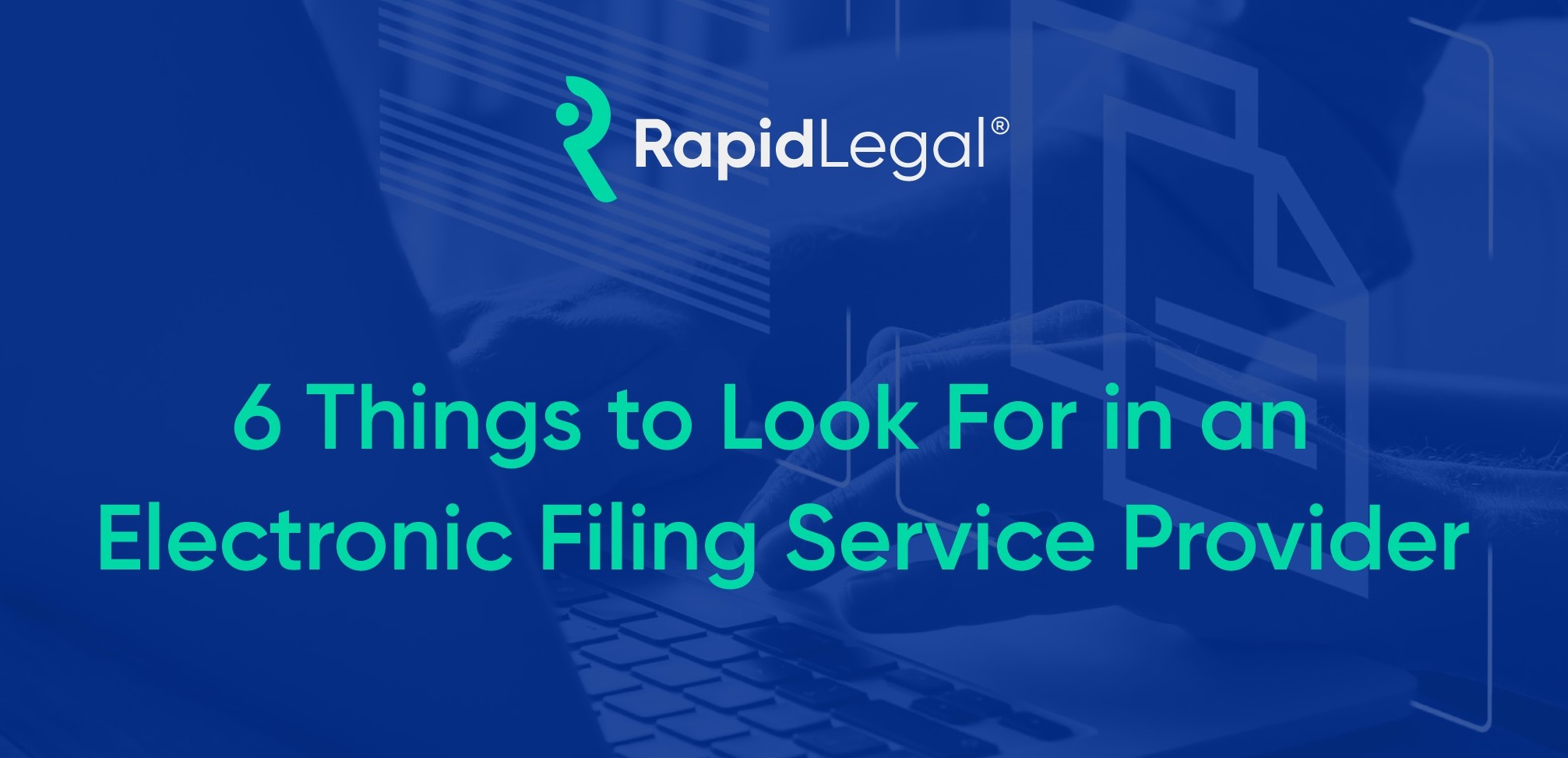
In cases where eFiling is mandatory or permissive, courts in California typically require legal professionals and self-represented litigants to electronically file legal documents with them using an electronic filing service provider, or EFSP. EFSPs are expected to follow proper procedural requirements in a timely and accurate manner, otherwise, their client’s hearings could be delayed, or worse, their cases could be jeopardized.
What is an EFSP?
An EFSP is an Electronic Filing Service Provider that has been authorized and certified by a court, or the court’s technology provider, to integrate its software with the Court’s Case Management System (CCMS) or Electronic Filing Manager (EFM) to transmit and receive data, legal documents, and payments on behalf of end users – law firms, corporations, and the public at large.
EFSPs offer varying degrees of services, technological capabilities and expertise, including the number of court eFiling integrations, customer support, and breadth of litigation support services. It is critical to choose one that can mitigate risk while driving your firm’s innovation forward.
In this buying guide, you will learn six important factors to keep in mind when evaluating an EFSP and finding the right one for your organization.
#1: Service Performance
- Has processes and technology in place that maximize eFiling court acceptance
- Returns court-stamped documents and proofs according to the company’s Service Level Agreements on a consistent basis
- Shares performance metrics with customers such as eFiling Turnaround Times, Serve Success Rates, User Behavior and Order Data
Why It Matters: An EFSP that delivers reliable and transparent litigation support services ensures your filing and serving needs will be well-supported.
#2: Domain Experience & Expertise
- Possesses deep knowledge of CA state & local court rules, industry eFiling systems, and eFiling procedures
- Has several years of experience in your particular geographic location
- Offers complementary services and expertise in other areas such as courtesy copy delivery, records retrieval, and court research
Why It Matters: Where you are eFiling matters, and an EFSP that’s experienced in your area’s specific court rules and policies will be able to better serve you.
#3: Customer Support
- Offers multiple ways to contact customer support such as live chat, email, and phone
- Provides expert review of all documents to ensure proper formatting, filing, and more
- Delivers regular updates on the status of your legal documents
- Partners with clients and focuses on long-term client success by continually earning client trust in every interaction
Why It Matters: An EFSP that makes customer support a top priority ensures your documents will be filed & served correctly and reachable when you need it.
#4: Future-Ready Technology & Software Capability
- Is integrated with all eFiling courts, not just a few of them
- Provides an intuitive portal that is easy-to-use and delivers court-stamped documents and proofs of service back quickly and reliably
- Delivers custom reports and analytics
- Has the ability to integrate with accounting, practice management systems and more, to automate legal workflows and leverage data
Why It Matters: An EFSP that delivers more than just an eFiling portal, but also can leverage data, insights, and integrations to automate and better run your business means it can support you now and well into the future.
#5: Billing Processes
- Has clear and timely billing procedures
- Offers a seamless payment process tailored to a customer’s needs
- Provides in-depth itemized invoices including available payment methods, amount owed, unique invoice reference numbers, and more
- Answers any outstanding questions regarding service and court fees
Why It Matters: Detailed invoices and timely billing from an EFSP delivers greater cost visibility and control for your firm.
#6: Social Proof & Industry Reputation
- Has a proven track record of customer success and satisfaction
- Shares client testimonials on website and social platforms
- Has industry recognition from legal professionals and organizations who have partnered with the EFSP
- Offers case studies that showcase the EFSP’s former work
Why It Matters: Positive reviews from customers and other legal professionals prove an EFSP’s ability to provide reliable services.
Let’s Get Started
Now that you know what to look for in an EFSP, you’re ready to begin your search. For those needing to deliver legal documents fast and reliably, Rapid Legal is here to help. Create an account and start the eFiling process with us today.
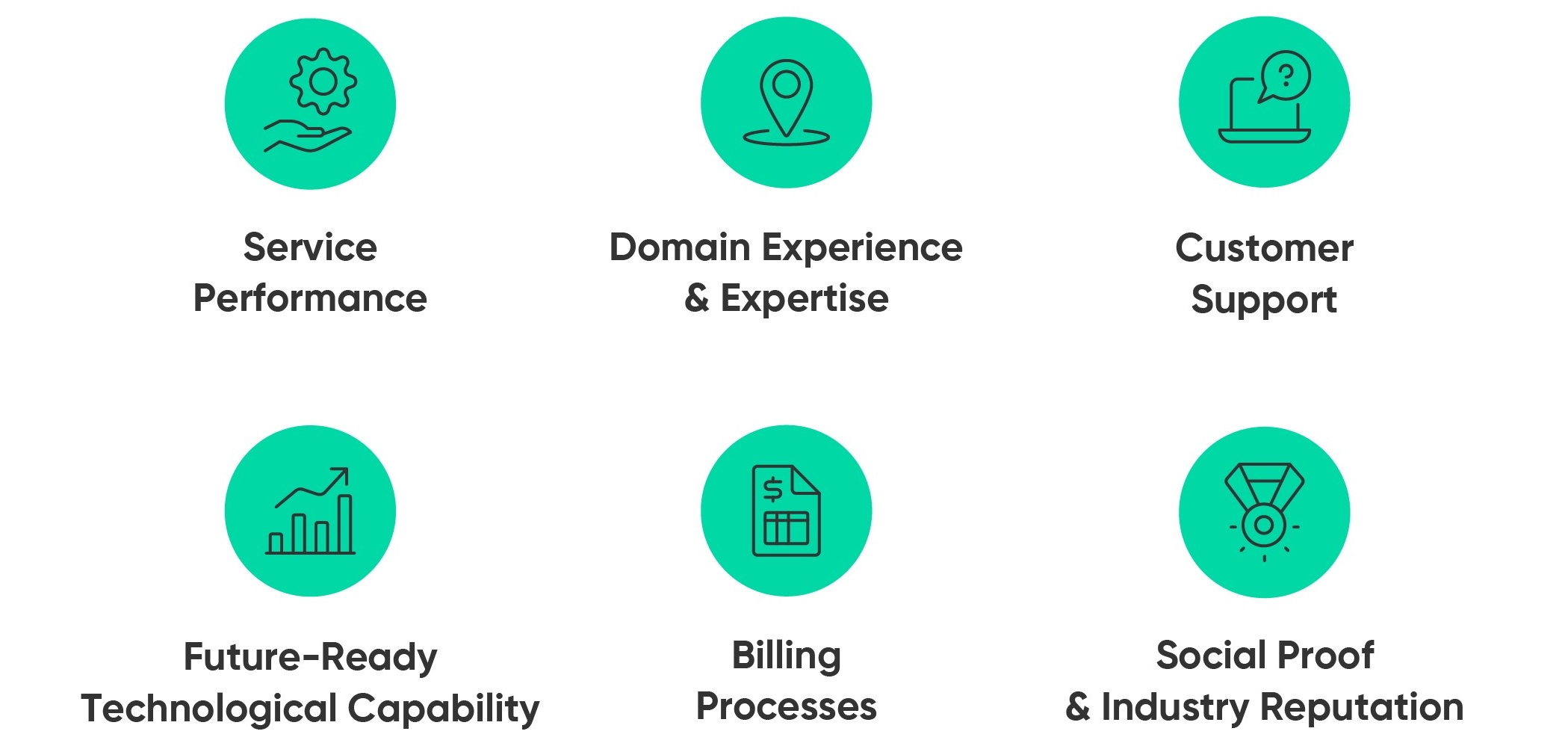
Exploring Stakeholders in the California Court eFiling Workflow

There are many key stakeholders that are involved in the submission, transmission and completion of California court eFilings. As a certified Electronic Filing Service Provider (EFSP) for 39 California courts and counting, we examine the main stakeholders of the California Court eFiling system. Who are the players? What are their roles? And why are they important?
California Court eFiling Players and Roles
A high-level overview of a typical eFiling order workflow looks very similar to the image depicted below. We take a closer look at the stakeholders involved throughout the workflow and system.
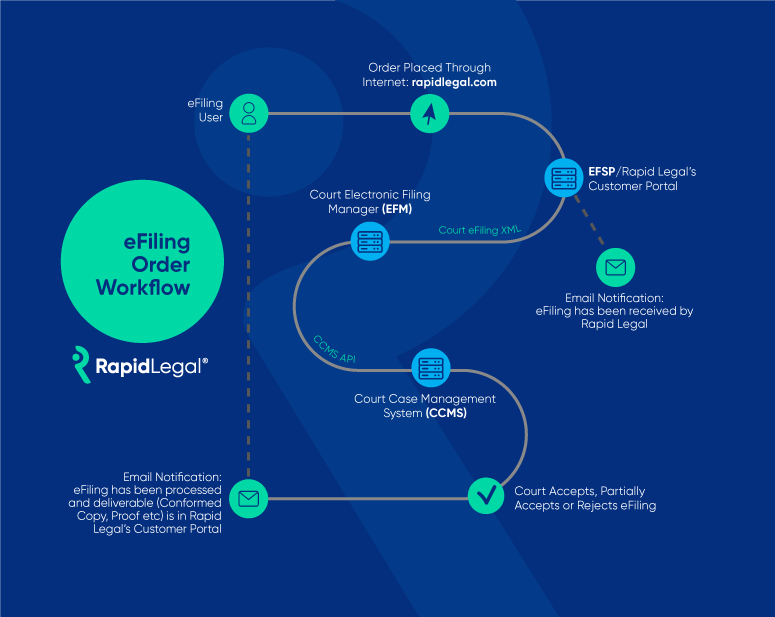
Key Stakeholder 1: The eFiling User
An eFiling user is a user of the eFile case’s Electronic Filing Service Provider (EFSP) and typically places an order and/or submits the case. This person may be the case initiator or the point of contact throughout the life of the case. There could be many eFiling Users for one case. Examples of an eFiling user include Paralegal, Office administrator, Attorney, Secretary, Pro-pers, EFSP Operations user, EFSP customer, court runner, field agent, and more.
Stakeholder 2: Case Participants
A case will consist of case participants which are people, businesses, or organizations involved in the case. This usually consists of a plaintiff (a person who brings a case against another in a court of law) and a defendant (in a civil suit, the person complained against; in a criminal case the person accused of the crime).
Stakeholder 3: Electronic Filing Service Provider (EFSP)
As mentioned above, an eFiling user places an order via an Electronic Filing Service Provider (EFSP), which is a company whose online portal has been certified to transmit documents to a court via an integration with an Electronic Filing Manager (EFM), such as Tyler or Journal Technologies (JTI). In addition to providing eFiling services, an EFSP also typically provides value-added services, training, and support to eFiling users.
As a certified Electronic Filing Service Provider (EFSP) for over 36 courts, Rapid Legal’s technology is integrated with various court Electronic Filing Managers (EFM). These integrations enable filers to electronically file documents directly with the Court through Rapid Legal’s portal.
Stakeholder 4: Technology Provider of Electronic Filing Manager (EFM) Software
Next, the Electronic Filing Manager (EFM) acts as an intermediate system on the Court’s side. This is the system that receives the filings and processes them for the court clerks to view and manage. The EFM connects to the court’s Case Management System (CMS). All courts must use an EFM to manage their backend system.
Click here to view our handy guide that outlines which Court uses which EFM, whether it is mandatory or permissive, case types for eFiling, and associated costs.
Stakeholder 5: The Court and Case Management System (CMS)
Lastly, the stage following the EFM is the Court’s Case Management System (CMS). This is the Court’s backend system that automates court processes, monitors case activities, and supports decision-making through the use of real-time data and analytics. A case management system consolidates and maintains all the information that is pertinent to a case. Users of the court’s CMS include personnel such as clerks, judicial officers, and judges.
Reference Table: California Court eFiling Stakeholders
| Stakeholder | Definition | Notes | Examples |
|---|---|---|---|
| eFiling User | A User of the eFile case’s Electronic Filing Service Provider (EFSP) system. | This person may be the case initiator or the point of contact throughout the life of the case. There could be many eFiling Users for one case. | Paralegal, Office administrator, Attorney, Secretary, Pro-pers, EFSP Operations user, EFSP customer, court runner or field agent. |
| Case Participants | People, businesses, or organizations involved in the case; consisting of a plaintiff (a person who brings a case against another in a court of law) and the defendant (in a civil suit, the person complained against; in a criminal case the person accused of the crime). | Self-represented litigants are not required to eFile in California. | Plaintiff, Defendant, (or Attorney, if case participant is represented) |
| Electronic Filing Service Provider (EFSP) | A company whose online portal has been certified to submit documents to a court via an integration with an Electronic Filing Manager (EFM). | An ESFP may also provide value-added services, training, and support for eFiling. | Rapid Legal is an example of an EFSP. |
| Electronic Filing Manager (EFM) | The EFM acts as an intermediate system on the Court’s side. This is the system that takes in filings and processes them for the courthouse clerks to view. The EFM connects to the Court’s case management system (CMS). | All courts must use an electronic filing manager (EFM) to manage their backend system. One of these, in particular, requires filers to connect their Rapid Legal account to the EFM to help with proper tracking of cases, parties, and attorneys associated with cases. | Tyler (Odyssey eFileCA), Journal Technlogies (JTI), etc. California allows each county to select its own technology vendor. Click here to view our handy guide that outlines which Court uses which EFM. |
| Court Case Management System (CMS) | This is the Court’s backend system that automates Court processes, monitors case activities, and supports decision-making through the use of real-time data and analytics. | The stage following the EFM is the court Case Management System (CMS). After your filing has been accepted, your documents become a permanent part of the court record. A CMS helps to consolidate all the information that is pertinent to a case. The system also supplies all the tools that may be necessary for a follow up on the matter. | |
| Court | A government institution, with the authority to adjudicate legal disputes between parties and carry out the administration of justice in civil, criminal, and administrative matters in accordance with the rule of law. | Parties that work at the Court may include the clerk, judicial officer, and the judge. | Any courthouse, i.e.: LA County Superior Court, OC Superior Court, district courts, Court of appeals, etc. |
Looking to get started with eFiling? Check out our handy guide that provides an overview of eFiling, some common eFiling reasons to watch out for, a checklist of how to carefully select an Electronic Filing Service Provider (EFSP), and much more.
Ready to create an account? Place an eFile order today.
About Rapid Legal
For more than 25 years, Rapid Legal has helped to define and transform the legal support services industry with its vision and commitment to customers, the courts, and a party’s right to due process under the law.
Trusted by thousands of law firms, government agencies and companies, Rapid Legal leverages its deep industry and technology expertise, and a best-in-class legal services cloud management platform, LegalConnect®, for delivering premium legal support services including electronic filing of court documents (“eFiling”), physical court filings, and service of process.
CA Court eFiling Requirements – Part Three

This is the 3rd and final post in our 3 part series created to answer the question, “What CA courts are moving to eFiling and when?”
Here in Part Three, we bring you the current state of eFiling in San Diego County Superior Court, Alameda County Superior Court and two other honorable mentions: Sacramento and Stanislaus Counties.
San Diego County Superior Court
March 4, 2013: eFiling opened up in San Diego’s Central Division.
June 30, 2014: eFiling opened up in San Diego’s North County Division.
MANDATED:
San Diego Superior Court requires the following actions to be eFiled:
- Provisionally Complex (Antitrust, Construction Defect, Mass Tort, Environmental/Toxic Tort and Securities Litigation Cases)
A couple of caveats exist:
Self-represented litigants are not required to eFile or electronically serve documents in a mandatory eFile case. If they choose to do so, however, they may eFile and electronically serve documents; or they may otherwise be ordered to eFile and/or electronically serve documents by the Court.
A party may, in writing and by ex-parte application, request an exemption, which can only by granted by Court Order. This request must be made to the judge or department to which the case is assigned.
For mandated eFiling cases, San Diego Superior Court has designated One Legal as the court-approved eFiler. For all other cases, Rapid Legal can assist you.
Take Note! The following filings or case types are NOT ELIGIBLE for eFiling, and must be filed in paper form:
- Name Change (Safe at Home) Petitions
- Civil Harassment TRO/RO
- Workplace Violence TRO/RO
- Elder Abuse TRO/RO
- Transitional Housing Program Misconduct TRO/RO
- School Violence Prevention TRO/RO
- Out-of-State Commission Subpoenas
- Undertaking/Surety Bonds
- Requests for Payment of Trust Funds
- Writs, Abstracts, or Warrants to be issued
- Notice of Appeal of Labor Commissioner
- Settlement Conference Briefs (to be lodged)
- Confidential documents lodged conditionally under seal Interpleader actions pursuant to CC2924j
Okay, so maybe you’re still not sure which documents need to be eFiled in San Diego? Feel free to give our team a call at 800.366.5445!
You can also view the Court’s FAQs here.
What’s next for San Diego?
The Court is striving to do more to build out its technology and infrastructure to support e-Filing for all Civil Actions. We’ll keep you posted with new developments as they arise.
Alameda County Superior Court
Alameda Court is preparing for the launch of a new Case Management System for juvenile, criminal, family, civil and probate case types. Juvenile and criminal case types are expected to launch in December 2015, with the remaining to go live December, 2016. The Court intends to implement e-filing concurrently.
How about other Counties in California, you may be asking?
While they are not expected to go to full-fledged eFiling right away, there are two other Counties which show some indication of moving in that direction:
Sacramento County Superior Court
Sacramento County has allowed eFiling for Unlawful Detainers (UDs) and Small Claims for several years now. They have made no other provisions, though, as of this writing. Rapid Legal continues to monitor Sacramento for further developments in e-Filing.
Stanislaus County Superior Court
It is projected that by 2016, Stanislaus will look to roll out eFiling.
Rapid Legal will continue to stay in contact with the Courts. Our aim is to continue providing eFiling to our customers to the fullest extent possible, and as each court makes eFiling available.

